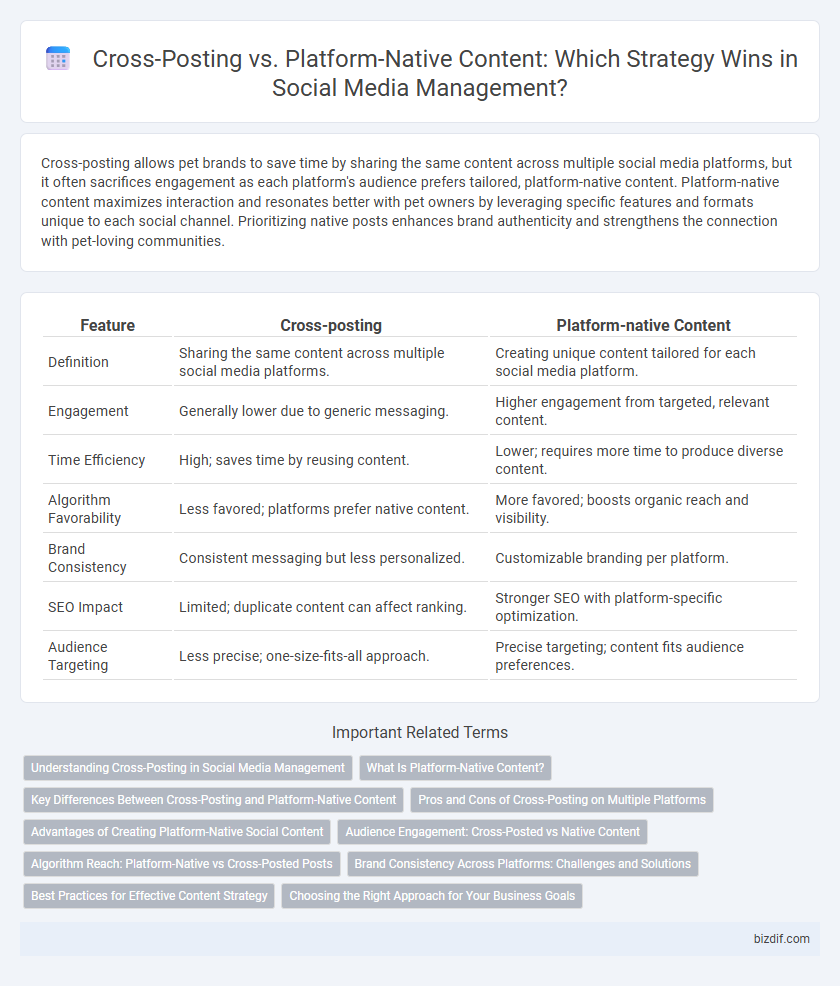Cross-posting allows pet brands to save time by sharing the same content across multiple social media platforms, but it often sacrifices engagement as each platform's audience prefers tailored, platform-native content. Platform-native content maximizes interaction and resonates better with pet owners by leveraging specific features and formats unique to each social channel. Prioritizing native posts enhances brand authenticity and strengthens the connection with pet-loving communities.
Table of Comparison
| Feature | Cross-posting | Platform-native Content |
|---|---|---|
| Definition | Sharing the same content across multiple social media platforms. | Creating unique content tailored for each social media platform. |
| Engagement | Generally lower due to generic messaging. | Higher engagement from targeted, relevant content. |
| Time Efficiency | High; saves time by reusing content. | Lower; requires more time to produce diverse content. |
| Algorithm Favorability | Less favored; platforms prefer native content. | More favored; boosts organic reach and visibility. |
| Brand Consistency | Consistent messaging but less personalized. | Customizable branding per platform. |
| SEO Impact | Limited; duplicate content can affect ranking. | Stronger SEO with platform-specific optimization. |
| Audience Targeting | Less precise; one-size-fits-all approach. | Precise targeting; content fits audience preferences. |
Understanding Cross-Posting in Social Media Management
Cross-posting involves sharing the same content across multiple social media platforms to maximize reach and maintain brand consistency. However, platform-native content tailored specifically for each channel tends to generate higher engagement due to its alignment with unique audience preferences and platform features. Effective social media management balances cross-posting efficiency with the customization of content to leverage each platform's strengths and algorithmic preferences.
What Is Platform-Native Content?
Platform-native content is specifically created and optimized for a single social media platform, leveraging its unique features, algorithms, and audience preferences to maximize engagement. Unlike cross-posting, which involves sharing the same content across multiple platforms, platform-native content often includes tailored formats such as Instagram Stories, TikTok videos, or Twitter threads. This targeted approach enhances visibility, interaction rates, and overall effectiveness in social media management strategies.
Key Differences Between Cross-Posting and Platform-Native Content
Cross-posting involves sharing the same content across multiple social media platforms, creating uniformity but often sacrificing engagement due to platform-specific nuances. Platform-native content is tailored to each platform's unique features, audience preferences, and algorithms, resulting in higher interaction and reach. Understanding these key differences helps brands optimize their social media strategies for maximum impact and audience resonance.
Pros and Cons of Cross-Posting on Multiple Platforms
Cross-posting on multiple platforms saves time and ensures consistent brand messaging across social media channels, increasing content reach and audience engagement. However, it may lead to reduced engagement due to platform-specific audience preferences and algorithmic limitations, as native content often performs better by catering to each platform's unique features and user behavior. Brands must balance efficiency with customization to maximize social media effectiveness.
Advantages of Creating Platform-Native Social Content
Creating platform-native social content maximizes engagement by tailoring posts to the unique algorithms and user behaviors of each social media site. This approach enhances authenticity and relevance, leading to higher interaction rates compared to generic cross-posted content. Brand visibility and message clarity improve significantly when content leverages platform-specific features like Stories on Instagram or retweets on Twitter.
Audience Engagement: Cross-Posted vs Native Content
Cross-posted content often reaches a broader audience quickly but typically experiences lower engagement rates compared to platform-native content, which is tailored to the unique features and audience behaviors of each social media site. Native content benefits from optimized format, timing, and platform-specific algorithms, resulting in higher likes, shares, comments, and overall interaction. Brands aiming to maximize audience engagement should prioritize creating authentic, platform-native posts while selectively using cross-posting to maintain consistent messaging across channels.
Algorithm Reach: Platform-Native vs Cross-Posted Posts
Platform-native posts typically achieve higher algorithmic reach due to better engagement signals and preferential treatment from social media algorithms. Cross-posted content often experiences reduced visibility because platforms detect repurposed material and limit its distribution to encourage original content creation. Optimizing for platform-specific formats and audience preferences significantly enhances reach and interaction rates.
Brand Consistency Across Platforms: Challenges and Solutions
Maintaining brand consistency across platforms poses challenges due to varying content formats and audience preferences, which can dilute brand identity when relying on cross-posting strategies. Platform-native content allows tailored messaging that resonates with each platform's unique user base while preserving core brand elements such as logos, color schemes, and tone of voice. Employing content management tools and cohesive style guides ensures uniformity in visual and verbal branding, overcoming fragmentation and reinforcing brand recognition across social media channels.
Best Practices for Effective Content Strategy
Cross-posting maximizes reach by distributing consistent messages across multiple social media channels, saving time while maintaining brand identity. Platform-native content leverages unique features and user behaviors of each platform, enhancing engagement and authenticity with tailored visuals and formats. Balancing both approaches through audience analysis and performance metrics drives optimal content strategy and ROI.
Choosing the Right Approach for Your Business Goals
Cross-posting saves time by sharing identical content across platforms, but it may reduce engagement due to lack of platform-specific optimization. Platform-native content tailored to each social media channel enhances audience interaction and brand authenticity, aligning better with unique user behaviors. Businesses should evaluate their goals, resources, and audience preferences to decide which strategy maximizes reach and conversion effectively.
Cross-posting vs Platform-native content Infographic

 bizdif.com
bizdif.com